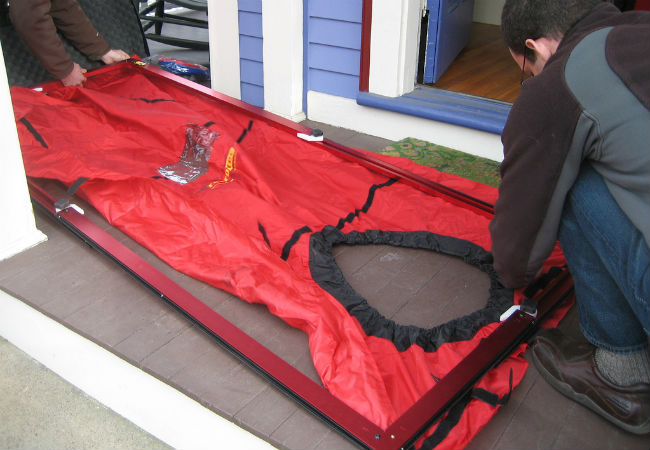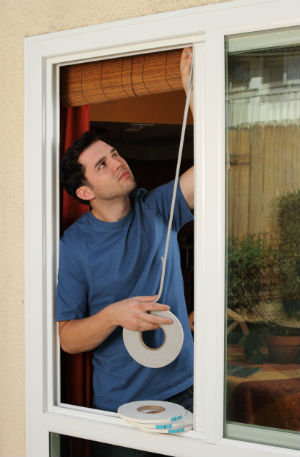We may earn revenue from the products available on this page and participate in affiliate programs. Learn More ›
Drafty homes waste energy, yet most homeowners don’t have a clue as to how energy inefficient their homes may actually be. With rising utility costs and the global conservation push, we’re seeing greater regulation of construction methods and mandatory energy testing at the state and local levels. As part of an energy audit, a number states, including New York, Florida, Michigan, and Georgia, already require blower door tests—which ascertain how airtight a structure is—in all newly constructed houses, and more states may soon add the requirement to their building codes.
RELATED: 18 Ways You’re Accidentally Wasting Energy
Blower door tests aren’t limited to new home construction, however, so if you’d like to find out how energy efficient your home really is (or isn’t!), you may wish to have the procedure performed at your place—because while no house is 100 percent airtight, the goal is to make it as airtight as possible to conserve energy. Read on to have all your questions answered.
What Is a Blower Door Test?
Blower door tests are performed by certified energy auditors to determine to what degree a home is airtight. A temporary “blower door” equipped with a powerful fan is fitted into the frame of an existing front or back door, and when the fan is turned on, it sucks the air out of the house and blows it outside. Digital gauges compare the difference in air pressure between the inside air and the outside air to determine how much air is leaking into the house.

What Happens During the Test?
Once the energy auditor arrives, it takes between 10 and 20 minutes to install the blower door inside an existing door frame, an additional 10 to 15 minutes to prep the house for the test, and about 15 minutes to run the test. Here’s what’s involved:

- The blower door is fitted inside the door frame.
- All exterior doors (except the one where the blower door is to be installed) are closed.
- All windows are closed.
- Interior doors are left open to ensure that all rooms in the home are included in the test.
- Pilot lights from stoves and water heaters are extinguished.
- Flues in wood-burning stoves and fireplaces are closed.
- The auditor calculates the total volume of airspace inside the house.
- The fan in the blower door is engaged, and digital gauges monitor the air pressure inside and outside the home.
- Another auditor walks through the house and checks for drafts. The fan is so powerful that as it sucks the air out of the house, it draws additional air in through unsealed gaps in the home. These are called “penetrations.” The auditor will feel around doors, windows, and vents for drafts and will also use a small fog generator to pinpoint drafts that are too weak to feel. When there’s no draft, the fog will hover in the air, but if a draft is present, the fog will quickly blow away.
Note: Prior to a blower test in older homes (pre-1978), the energy auditors look for friable (deteriorating) asbestos in the attics and basements. If found, they will not perform a blower test. Because the suction generated during the test is so strong, there’s a risk that it could dislodge some asbestos, a serious health hazard should it become airborne. The asbestos can be removed by an asbestos removal expert and then the home can be tested.
What Do the Results Mean?
In addition to looking for drafts, a manometer (a gauge that measures pressure) records the difference between the outside and indoor air pressure before, during and after the blower test, and the auditor uses those numbers to calculate how airtight the house is. You’ll receive a report at the end of the test, which will allow you to see how airtight your home is and where you can take steps to improve its efficiency.
There will be a reading for the house’s “ACH,” which stands for “Air Changes per Hour.” This indicates how many times the volume of air in your home would be completely replaced in one hour’s time if the blower fan continued to run. An ACH of “4” indicates a reasonably airtight home.
- Some states, such as Michigan, require new homes to have a minimum ACH of 4 in order to receive a Certificate of Occupancy.
- An ACH of 5 indicates a semi-airtight home and is a favorable result for older homes.
- ACH readings of 6 to 9 indicate a moderately leaky home.
- ACH readings over 9 indicate a very leaky home.
You’ll also note the “CFM” (cubic feet per minute) on test results, which indicates how much air moved through the fan during the test. This number is less important than the ACH number in gauging the airtightness of your home, but in a leaky home, the CFM will be higher because more air is being drawn into the home via the leaky penetrations.
- CFM below 1250 indicates reasonably airtight home.
- CFM between 1300 to 3000 indicates a moderately leaky home.
- CFM over 3000 indicates a leaky home that would definitely benefit from sealing the leaks.
The test report will also list all the areas of the home where drafts were found. This allows the homeowner (or the builder) to pinpoint the areas that need to be sealed.
How Much Does a Blower Door Test Cost?
In new construction, a blower door test is performed at the completion of the home-building process, and if the house is found to be drafty, the builder will have to seal the leaks and then have the house retested. The cost can run as much as $450 dollars, depending on the square footage of the house. To have an existing home tested, first contact your power company, as some offer blower door tests at reduced rates for customers. North Arkansas Electric Cooperative (NAEC), for instance, charges only $100 for a blower door test, no matter how big the house. If your power company doesn’t offer the service at a lower price, you can contact a local energy
auditor.
Is There a DIY Alternative?
Blower door tests are performed by trained and certified energy auditors, but a homeowner can conduct a mini test to help pinpoint leaky areas of the home. The following will help you conduct your own blower test.
- Place a powerful box fan—the type used to ventilate garages and shops—in an open window. Look for a fan with the ability to move 2,000 cubic feet of air per minute (CFM). (You can rent one for around $15 per day from a construction rental store.)
- Seal off all air gaps between the fan and the window frame with duct tape.
- Close all exterior doors and windows but leave interior doors open.
- Extinguish pilot lights.
- Close flues.
- Turn on the fan to begin blowing air out of the house.
- Use a fog-generating tool, such as the Zero Toys Wizard Stick (available from Amazon) to detect drafts around your home.
- Check in crawlspaces, around pipes, under sinks (where plumbing penetrations are often leaky), around wall outlets and switches, and around the edges of your windows. You’ll be able to see the fog blow away when a draft is present.
While a DIY test won’t give you the air exchange rate in your home, it will let you know where you can make repairs to seal around leaky penetrations.
RELATED: 12 Ways to Make an Old Home More Energy Efficient
How Can I Make My Home More Airtight?
If the blower door test finds that your home is draftier than it should be, you’ll probably want to take steps to seal the leaks. Depending on the leak’s location, you may be able to tackle most of the repairs yourself.

DIY FIXES
- Apply new caulking around drafty windows.
- Expandable foam caulking can be used to seal gaps behind drafty baseboards.
- Insert insulating foam gaskets (made especially for this purpose) behind outlet and switch covers to block drafts.
- Install a louvered vent cover on your stove vent (on the outside), to block backward air flow into the house.
- Replace rubber sweeps on the bottoms of exterior doors to create a tight seal.
PROFESSIONAL FIXES
- If your fireplace or wood-burning stove flue is drafty even when closed, have a chimney repair company come out and seal the air leaks around it—or replace the flue.
- If your windows are old and loose in their frames, caulking can only do so much to keep out drafts. Consider having energy-efficient replacement windows installed.


